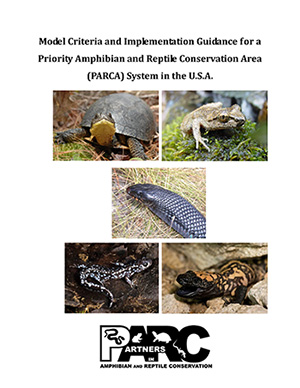PARCAS: Priority Amphibian and Reptile Conservation Areas
 Amphibians and reptiles are experiencing exceptional declines, with habitat loss and fragmentation among the leading threats to both groups. Furthermore, municipalities, land trusts, land managers and large land owners are increasingly seeking guidance in identifying discrete areas of the landscape that provide exceptional biodiversity value. In response, PARC developed the Priority Amphibian and Reptile Conservation Areas (PARCAs) project.
Amphibians and reptiles are experiencing exceptional declines, with habitat loss and fragmentation among the leading threats to both groups. Furthermore, municipalities, land trusts, land managers and large land owners are increasingly seeking guidance in identifying discrete areas of the landscape that provide exceptional biodiversity value. In response, PARC developed the Priority Amphibian and Reptile Conservation Areas (PARCAs) project.
Download the PARCAs criteria and implementation plan here!
PARCAs are a nonregulatory designation whose purpose is to raise public awareness and spark voluntary action by landowners and conservation partners to benefit amphibians and/or reptiles. Areas are nominated using scientific criteria and expert review, drawing on the concepts of species rarity, richness, regional responsibility, and landscape integrity. Modeled in part after the Important Bird Areas program developed by BirdLife International, PARCAs are intended to be coordinated nationally but implemented locally at state or regional scales.
Importantly, PARCAs are not designed to compete with existing landscape biodiversity initiatives, but to complement them – providing an additional spatially explicit layer for conservation consideration.
PARCAs are intended to be established in areas:
- Capable of supporting viable amphibian and reptile populations
- Occupied by rare, imperiled, or at-risk species, and
- Rich in species diversity or endemism
There are four major steps in implementation:
- Regional PARC task teams or state experts can use the criteria and modify them when appropriate, to designate potential PARCAs in their area of interest.
- Following the identification of all potential PARCAs, the group then reduces these to a final set of exceptional sites that best represent the area of interest.
- Experts and stakeholders in the area of interest collaborate to produce a map that identifies these peer-reviewed PARCAs.
- Final PARCAs are shared with the community to encourage the implementation of voluntary habitat management and conservation efforts. PARCA boundaries can be updated as needed.
Suggested Citation
PARCA Criteria Development Team
Ron Sutherland, SE PARC (Wildlands Network), Chair
Phillip deMaynadier, NE PARC (Maine Dept. of Inland Fisheries & Wildlife)
Margaret Griep, SE PARC (USFS)
Randy Jennings, SW PARC (Western New Mexico University)
Karen Kinkead, MW PARC (Iowa Dept. of Natural Resources)
Audrey Hatch, NW PARC (formerly Oregon Dept. of Fish & Wildlife)
PARCAs Progress Timeline
- 2007 – 2009: Established a national PARCA task team, reviewed existing programs that might inform PARCA methodology (BirdLife International IBAs, Canadian Important Amphibian & Reptile Areas [IMPARAs] and Iowa Department of Natural Resources’ Amphibian & Reptile Conservation Area [ARCA]).
- 2009 – 2011: Developed science-based criteria based on species rarity and richness, regional responsibility, landscape integrity, and program implementation guidance. Circulated draft criteria for expert review.
- 2011 – 2012: Secured USFWS grants from the North Atlantic and South Atlantic Landscape Conservation Cooperatives to begin implementing PARCA criteria.
- 2013: PARCA document available online!

